I have recently returned from a trip to India. Lots of really good surveying fun (and, no, that is not an oxymoron). I travelled with my daughter. We spent most of our time in Delhi, but popped up to Dehra Dun for some theodolite worshiping at one stage. More about that another day.
This first blog is about Jantar Mantar in New Delhi which was a tremendous find. To quote from various boards around the site...
"This jantar mantar is the oldest of a unique set of 18 century observatories constructed by Jai Singh II. It is one of five built from 1724 onwards as directed by Mughal emperor Muhammad Shah to revise the calendar and astronomical tables.
"The Samrat Yantra of the ‘King of Instruments’ is the largest and most imposing of the yantras at the Delhi Observatory.
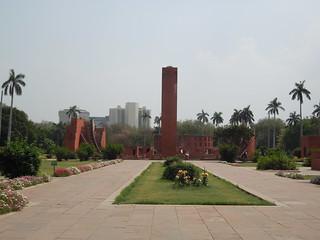
"This yantra exists in all the extant jantar mantars and is counted amongst Jai Singh’s high precision instruments. A chamber in its eastern quadrant contains another yantra called the Shasthamsa Yantra.
"Measurements: 20.73m high, 38.10m from east to west and 34.60m from north to south.
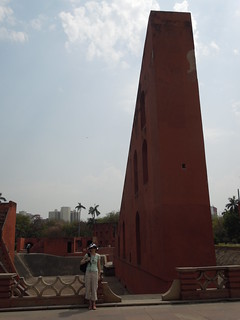
"Function: Measurement of the apparent solar time or local time of a place and the sun’s declination.
"Working: The yantra consists of an inclined wall parallel to the earth’s axis flanked by two semicircular quadrants. All these surfaces have scales marked on them. The quadrants represent the place of the equator and are marked in hours, degrees and minutes. The time at a given moment may be read by the shadow of the included wall (or gnomon) on the quadrants.
"The misra or composite yantra is composed of five different instruments. This yantra is unique to the Delhi Observatory. It s believed to have been constructed by Maharaja Madho Singh (1751-68), the son of Maharaja Sawai Jai Singh II. The five component yantras are the dakshinottara bhitti, samrat (in two halves), niyat chakra, karka rasivalaya and the western quadrant.
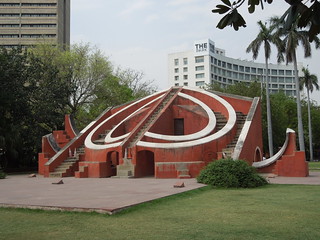
"The dakshinottara was also built in the Jaipur, Ujjain, Varanasi and Mathura observatories. It is a modified version of the portable meridian dial present in Greek, Arabic, Hindu and European systems of astronomy. The dakshinottara bhitti of the misra yantra is in the form of a graduated semicircle located on the eastern wall.
"Function: Measurement of the meridian altitude of a celestial object. It is most suitable for measuring the altitude of the sun.
"The niyat chakra or ‘fixed arc’ occupies the centre of the misra yantra. It consists of four semicircular scales on either side of a central gnomon. The scales are included to the meridian plane at different degrees.
"Function: Measurement of the declination of an object at intervals of a few hours as the object moves east to west in the sky during the period of the day. The niyats are apparently meant to duplicate the readings for the meridian arcs at four different locations the globe: Notkey in Japan, Serichew in Pic Islands, Zurich in Switzerland and Greenwich in England.
"The karka rasivalaya or circle of the sign of cancer consists of the large graduated semicircle marked on the northern wall of the misra yantra. This wall is inclined to the vertical at an angle of about 5 degrees, and is parallel to the plane of the tropic of cancer. On June 21, when the sun is at the tropic of cancer, its rays graze the instrument at noon.
"Function: Measurement of the longitude of a celestial object, such as the moon at the moment when the first point of the sign of cancer is on the meridian. It was designed to measure to the nearest minute of an arc.
"The samrat yantra of the misra yantra is construction in two halves to be used before and after the noon hour.
"Function: Determining the local time.
"The taller western quadrant of the misra yantra has sometimes been identified as an agra or amplitude instrument.
"Function: Apparently for measuring the latitude and longitude of a celestial object once every 24 hours.
Near the back of the jantar mantar are a couple of circular buildings - rama yantra. These are best described as a large hollow drums with their top ends uncovered and a pole erected in the centre.

The observer could walk along the scales to make the necessary observations.
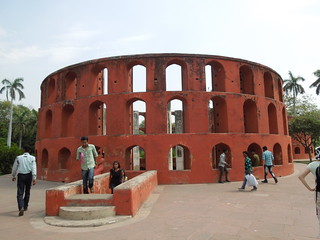
Or to have your photo taken.
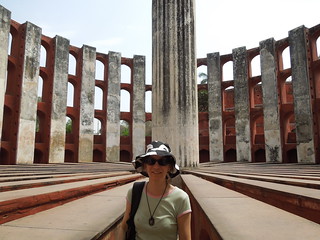
Scale marked in the uprights.
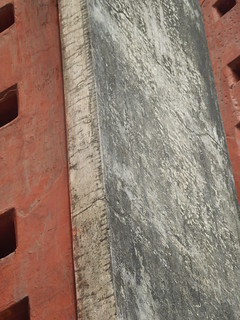
A very comprehensive report on all things yantar mantar can be found here.
Now I want to visit the rest!
This first blog is about Jantar Mantar in New Delhi which was a tremendous find. To quote from various boards around the site...
"This jantar mantar is the oldest of a unique set of 18 century observatories constructed by Jai Singh II. It is one of five built from 1724 onwards as directed by Mughal emperor Muhammad Shah to revise the calendar and astronomical tables.
"The Samrat Yantra of the ‘King of Instruments’ is the largest and most imposing of the yantras at the Delhi Observatory.

"This yantra exists in all the extant jantar mantars and is counted amongst Jai Singh’s high precision instruments. A chamber in its eastern quadrant contains another yantra called the Shasthamsa Yantra.
"Measurements: 20.73m high, 38.10m from east to west and 34.60m from north to south.

"Function: Measurement of the apparent solar time or local time of a place and the sun’s declination.
"Working: The yantra consists of an inclined wall parallel to the earth’s axis flanked by two semicircular quadrants. All these surfaces have scales marked on them. The quadrants represent the place of the equator and are marked in hours, degrees and minutes. The time at a given moment may be read by the shadow of the included wall (or gnomon) on the quadrants.
"The misra or composite yantra is composed of five different instruments. This yantra is unique to the Delhi Observatory. It s believed to have been constructed by Maharaja Madho Singh (1751-68), the son of Maharaja Sawai Jai Singh II. The five component yantras are the dakshinottara bhitti, samrat (in two halves), niyat chakra, karka rasivalaya and the western quadrant.

"The dakshinottara was also built in the Jaipur, Ujjain, Varanasi and Mathura observatories. It is a modified version of the portable meridian dial present in Greek, Arabic, Hindu and European systems of astronomy. The dakshinottara bhitti of the misra yantra is in the form of a graduated semicircle located on the eastern wall.
"Function: Measurement of the meridian altitude of a celestial object. It is most suitable for measuring the altitude of the sun.
"The niyat chakra or ‘fixed arc’ occupies the centre of the misra yantra. It consists of four semicircular scales on either side of a central gnomon. The scales are included to the meridian plane at different degrees.
"Function: Measurement of the declination of an object at intervals of a few hours as the object moves east to west in the sky during the period of the day. The niyats are apparently meant to duplicate the readings for the meridian arcs at four different locations the globe: Notkey in Japan, Serichew in Pic Islands, Zurich in Switzerland and Greenwich in England.
"The karka rasivalaya or circle of the sign of cancer consists of the large graduated semicircle marked on the northern wall of the misra yantra. This wall is inclined to the vertical at an angle of about 5 degrees, and is parallel to the plane of the tropic of cancer. On June 21, when the sun is at the tropic of cancer, its rays graze the instrument at noon.
"Function: Measurement of the longitude of a celestial object, such as the moon at the moment when the first point of the sign of cancer is on the meridian. It was designed to measure to the nearest minute of an arc.
"The samrat yantra of the misra yantra is construction in two halves to be used before and after the noon hour.
"Function: Determining the local time.
"The taller western quadrant of the misra yantra has sometimes been identified as an agra or amplitude instrument.
"Function: Apparently for measuring the latitude and longitude of a celestial object once every 24 hours.
Near the back of the jantar mantar are a couple of circular buildings - rama yantra. These are best described as a large hollow drums with their top ends uncovered and a pole erected in the centre.

The observer could walk along the scales to make the necessary observations.

Or to have your photo taken.

Scale marked in the uprights.

A very comprehensive report on all things yantar mantar can be found here.
Now I want to visit the rest!
No comments:
Post a Comment